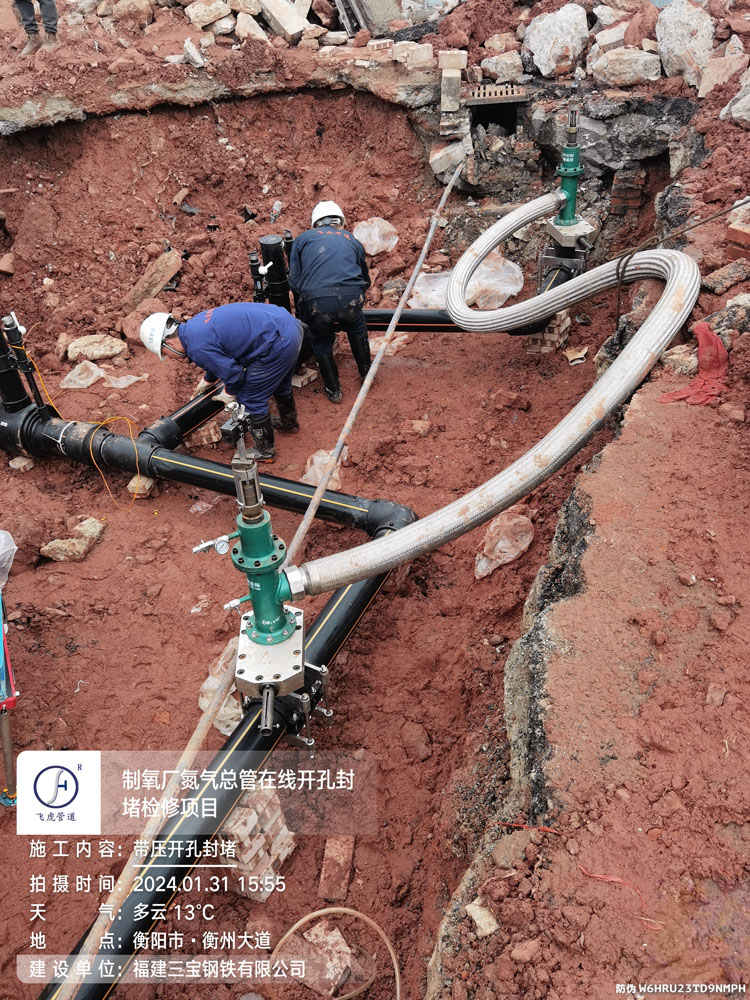Understanding PE Hot Tapping
PE Hot Tapping for HDPE Pipelines is a technique that allows pipeline operators to create connections to existing pipelines without shutting down the system. This method is particularly valuable for HDPE pipelines due to their flexibility, durability, and high-pressure resistance. Unlike traditional pipeline connection methods that require shutdowns, hot tapping enables live pipeline operations to continue uninterrupted. It is commonly used in gas, water, oil, and chemical pipelines where continuous flow is critical to operations. The method is ideal for expanding service networks, installing new branches, or performing maintenance without interrupting service. By allowing access to a pipeline while it remains operational, hot tapping improves efficiency, reduces downtime, and lowers overall operational costs. Industries and utilities increasingly rely on this technique to maintain infrastructure while minimizing disruptions to customers and industrial processes.
How PE Hot Tapping Works
The process of PE hot tapping for HDPE pipelines begins with a detailed assessment of the pipeline and system pressure. A branch fitting or saddle is securely installed on the live pipeline, followed by the attachment of specialized hot tapping equipment. A cutting device is then used to create an opening in the pipeline, allowing connection to the new branch or service line. Technicians continuously monitor pressure and flow to ensure safety and maintain system stability. High-quality equipment is crucial for ensuring precise cutting and minimizing the risk of leaks. Safety measures, such as pressure monitoring, emergency shutoffs, and personnel protective equipment, are standard during the procedure. Hot tapping is a controlled, non-invasive method that preserves the integrity of HDPE pipelines while allowing modifications or expansions without halting operations.
Key Benefits of PE Hot Tapping
One of the most significant advantages of PE hot tapping for HDPE pipelines is the ability to maintain uninterrupted service during modifications. Unlike traditional approaches that require full shutdowns, hot tapping allows pipeline operations to continue, avoiding costly downtime. This results in substantial operational savings, as service interruptions can have serious financial and logistical impacts. Environmental safety is enhanced since the technique reduces the likelihood of spills, leaks, or contamination during the procedure. The method also protects pipeline integrity by allowing localized, precise access without compromising the rest of the system. PE hot tapping is flexible, accommodating pipelines of different sizes, pressures, and materials. Overall, it improves operational efficiency, supports safety compliance, and reduces maintenance challenges for pipeline operators across industries.
Applications Across Industries
PE hot tapping for HDPE pipelines is widely applied across multiple sectors where continuous operation is essential. Gas distribution networks use this method for adding branches or servicing high-pressure pipelines without disrupting supply. Water and wastewater utilities rely on hot tapping for expanding service lines or performing repairs while keeping systems operational. Oil and chemical industries use it to modify pipelines safely in live systems, preventing costly interruptions. Industrial facilities benefit from hot tapping when bypass lines, emergency access, or system expansions are needed quickly. The technique integrates with modern monitoring systems to track pressure, flow, and pipeline integrity during operations. Its versatility ensures that municipalities, utility providers, and industrial operators can perform modifications efficiently without affecting ongoing service. Hot tapping is also valuable in emergency scenarios, allowing immediate response to pipeline issues without halting flow.
Choosing the Right Service Provider
Selecting a skilled service provider is essential for effective and safe PE hot tapping operations. Experience and technical expertise are critical in handling high-pressure pipelines and specialized HDPE equipment. Providers should be evaluated based on equipment standards, certifications, and safety records. Trained technicians are crucial for ensuring precise cuts, secure fittings, and continuous monitoring throughout the procedure. The provider should demonstrate the ability to work with pipelines of varying diameters and pressures while adhering to industry safety protocols. Risk assessment, project planning, and emergency preparedness are vital components of a reliable service partner. Partnering with a reputable provider ensures reduced operational risks, maintained pipeline integrity, and minimized disruption to ongoing pipeline operations.
Safety Considerations and Best Practices
Safety is a top priority in PE hot tapping for HDPE pipelines. Before initiating any procedure, a thorough risk assessment is conducted to identify potential hazards and implement mitigation strategies. Emergency protocols are established to quickly address unexpected situations such as pressure surges or equipment failures. Routine inspection and maintenance of hot tapping equipment are crucial to ensure reliable performance. Technicians must be trained in handling high-pressure pipelines, hazardous materials, and specialized cutting equipment. Compliance with industry regulations and safety standards is mandatory during all operations. Measures are taken to protect both personnel and the surrounding environment while maintaining pipeline integrity. Following best practices ensures that hot tapping operations are safe, efficient, and minimally invasive to ongoing pipeline functions.
Future Trends and Innovations
PE hot tapping technology is evolving with advancements in equipment, safety, and monitoring capabilities. Modern hot tapping systems incorporate automated and sensor-driven components for enhanced precision and real-time feedback. Integration with smart monitoring systems allows operators to track pipeline pressure, flow, and health during operations, improving predictive maintenance. New materials and designs for hot tapping fittings and cutting devices enhance durability and compatibility with high-pressure HDPE pipelines. Industry standards are progressing to focus on environmental protection, operational efficiency, and safety compliance. Automation and remote monitoring reduce manual intervention, improving operational efficiency and minimizing human error. These innovations make PE hot tapping an increasingly safe, cost-effective, and sustainable method for live pipeline modifications and maintenance.
Frequently Asked Questions (FAQ)
1. What types of HDPE pipelines are compatible with PE hot tapping?
PE hot tapping is suitable for HDPE gas, water, oil, and chemical pipelines, offering versatility across multiple industries.
2. Can hot tapping be performed on high-pressure pipelines?
Yes, PE hot tapping is specifically designed for high-pressure HDPE systems, ensuring safe and controlled operations.
3. How long does a typical PE hot tapping procedure take?
The duration depends on pipeline size, pressure, and complexity of the modification, but it is generally faster than traditional shutdown methods.
4. Is PE hot tapping safe in environmentally sensitive areas?
Yes, the controlled procedure minimizes the risk of leaks, spills, and contamination, making it suitable for sensitive environments.
5. What are the cost benefits compared to traditional pipeline shutdowns?
Hot tapping reduces operational costs by avoiding full shutdowns, minimizing downtime, and maintaining continuous service.
6. How often should pipelines undergo hot tapping maintenance or modifications?
The frequency depends on pipeline usage, pressure, and operational requirements. Routine inspections and preventative planning help determine the optimal schedule.











